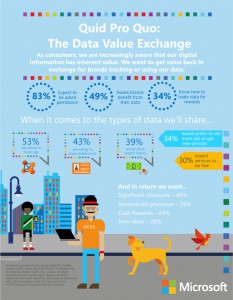SINGAPORE – 3 June 2015 – New global research from Microsoft uncovered fresh insights into consumers’ attitudes towards the exchange of personal data with brands. The Consumer Data Value Exchange Study, which is part of Microsoft’s bi-annual Digital Trends report, found that while 41% of global consumers consciously share personal information with brands, a larger percentage – 56% – believe that brands collect personal information from them without their explicit consent. This 15% gap in understanding of the brand-consumer data exchange can potentially put brands at risk of losing the trust of consumers over the use of their personal data.

The Consumer Data Value Exchange Study, which covered 16,500 respondents across 13 global markets including Australia, Brazil, Canada, Colombia, Egypt, Germany, Kenya, Mexico, Nigeria, Spain, South Africa, United Kingdom and the United States, also revealed the following findings:
- Consumers are more willing to share personal information such as their date of birth and address (56%) as well as basic demographics such as age, gender and marital status (53%) compared to biometrics such as facial recognition and fingerprints (11%).
- When it comes to the type of rewards consumers expect in exchange for their personal data, cash rewards are top of the list (64%), while ‘significant discounts’ also ranked as highly desirable (49%). In addition, more than one quarter (26%) of consumers are willing to exchange their data for services that help them discover new ideas, content and products, or for more streamlined processes (29%).
- On the cost that consumers are prepared to incur to get added value from brands, a third (34%) of consumers prefer to see more ads in return, while around the same amount (30%) say companies should offer services for free when personal data is being collected. In addition, a quarter (27%) would opt to share more information rather than pay for services.
“There is certainly a shift in consumer perception and attitudes. Our intuitive and emotive relationships with technology have created a world where sharing data leads to benefits for the user. Privacy is now less of a focus, instead, consumers are aware of the value of their data and are open to sharing this data with brands provided that there is a fair exchange of rewards in return,” said Natasha Hritzuk, Senior Director of Global Consumer Insights, Microsoft.
“Brands need to open about what information is being collected and how it is being used. This transparency, when combined with clear benefits, will help to alleviate consumer anxiety about the sharing of personal data. Though consumers today are much more demanding when it comes to the benefits they derive from brands in exchange for the use of their personal data, there are also huge opportunities for brands to engage with consumers at a deeper level when consumers’ trust in brands is not compromised,” Hritzuk continued.
Here are three key takeaways for brands from the Study:
- Be transparent. Consumers are more likely to see value in sharing data when there are obvious mutual benefits. Inconsistency in data policies and visibility of data usage can make the exchange seem one-sided. In the absence of transparency of information or clear value, the company appears to receive more benefit from collecting the data than what the consumer receives by sharing it.
- Respect boundaries. Brands must respect the nuances between different consumer groups. Different types of consumers will have different levels of comfort with the type of data they will share, and what they expect for it in return. For example, nervous data sharers tend to be more open to sharing more information if brands remove unnecessary steps and make their online activities simpler. On the other hand, savvy data sharers are much more open to sharing personal information in exchange for a range of rewards.
- Add value. With behavioral data topping the list of data types that consumers are willing to share in exchange for new services or offerings, brands can prioritize leveraging this data for more effective campaign targeting and engagement. For example, brands can provide content that is based on the target consumers’ interests, or a service that helps to simplify their lives.
In conclusion, data sharing is a personal choice for every consumer and each individual should be allowed to set their own limits within which businesses must respect in order to engage them effectively. Microsoft has defined six Data Sharer Profiles based on an individual’s willingness to share and their awareness of data, ranging from the Nervous Neophyte to the Savvy Sophisticate. Details on the range and implications of each of these profiles and an app for ascertaining your own personal profile are available at this link.
The Consumer Data Value Exchange Study is the result of a partnership with the Future Laboratory, Sentient Decision Science and Research Now to understand the value consumers expect from the digital platforms they use daily. It provides a look at current consumer understanding of sharing and data handling; perceptions of the utility of services received in return; and consumer expectations of technology platforms, brands and content providers moving forward. If the future is less about conventional “push” advertising and more about “pull” advertising, this research will help us crack the code on what data consumers will give and what they expect in return.
The full Consumer Data Value Exchange report can be downloaded here.
###
The Consumer Data Value Exchange Study covers 16,500 consumers across Australia, Brazil, Canada, Colombia, Egypt, Germany, Kenya, Mexico, Nigeria, Spain, South Africa, U.K. and the U.S.
About Microsoft
Founded in 1975, Microsoft (Nasdaq “MSFT”) is the worldwide leader in software, services and solutions that help people and businesses realize their full potential.
Note to editors: For more information, news and perspectives from Microsoft, please visit the Microsoft News Center at http://www.microsoft.com/news. Web links, telephone numbers and titles were correct at time of publication, but may have changed. For additional assistance, journalists and analysts may contact Microsoft’s Rapid Response Team or other appropriate contacts listed at http://www.microsoft.com/news/contactpr.mspx.




